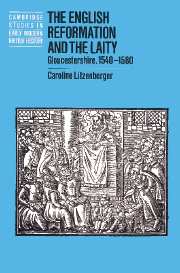Book contents
- Frontmatter
- Contents
- List of figures
- List of tables
- Acknowledgments
- Abbreviations and conventions
- Introduction
- 1 Setting the scene
- 2 Gloucestershire in the 1530s
- 3 The new diocese of Gloucester (1540–1546)
- 4 The advent of Edwardian Protestantism (1547–1553)
- 5 A return to the old religion (1553–1558)
- 6 The early years of Elizabeth's reign (1559–1569)
- 7 The clarification of the religious settlement (1570–1580)
- Conclusion
- Appendix A Sources and methodology
- Appendix B Results of wills analysis
- Appendix C Parish finances
- Bibliography
- Index
- Cambridge Studies in Early Modern British History
Conclusion
Published online by Cambridge University Press: 23 November 2009
- Frontmatter
- Contents
- List of figures
- List of tables
- Acknowledgments
- Abbreviations and conventions
- Introduction
- 1 Setting the scene
- 2 Gloucestershire in the 1530s
- 3 The new diocese of Gloucester (1540–1546)
- 4 The advent of Edwardian Protestantism (1547–1553)
- 5 A return to the old religion (1553–1558)
- 6 The early years of Elizabeth's reign (1559–1569)
- 7 The clarification of the religious settlement (1570–1580)
- Conclusion
- Appendix A Sources and methodology
- Appendix B Results of wills analysis
- Appendix C Parish finances
- Bibliography
- Index
- Cambridge Studies in Early Modern British History
Summary
From the break with Rome to the middle of Elizabeth's reign, the laity in the diocese and the realm dealt with a series of different and often contradictory definitions of acceptable religious beliefs and practices, as officials of the Crown and church worked to implement the form of religion in favour at the moment. The actual result of these efforts, however, was not always what those in power had in mind, as parishes and parishioners interpreted and implemented official policies in ways which suited their circumstances, religious preferences and past experiences. Within Gloucestershire, each region responded in a distinctive way, but even within regions there were variations as neighbouring parishes and their individual parishioners differed in the degree and nature of their conformity to the established faith.
Exposed to the opposing beliefs of the last two Bishops of Worcester, Hugh Latimer and John Bell, witnessing the removal of shrines such as the Blood of Hailes, and presented with the dissolution of the monasteries, the laity generally seem to have welcomed the more conservative policies of the early 1540s and the respite from change offered by John Wakeman's equivocal, conforming and passive episcopal style. The relief was to be brief, however, as Henry's death and Edward's accession brought with it a renewed impetus for the implementation of Protestantism. While a few people exuberantly welcomed this definitive swing toward religious reform, most of the Gloucestershire laity appear to have ‘ducked for cover’ in an attempt to ride out this particular religious storm, as they opted for outward parish conformity and ambiguity in their wills.
- Type
- Chapter
- Information
- The English Reformation and the LaityGloucestershire, 1540–1580, pp. 161 - 167Publisher: Cambridge University PressPrint publication year: 1997



